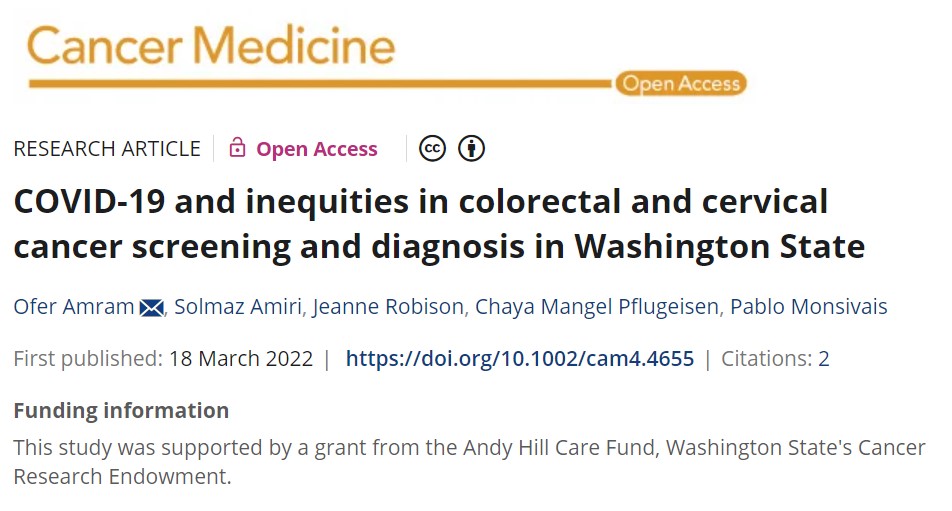COVID-19 Research
COVID-19 and inequities in colorectal and cervical cancer screening and diagnosis in Washington State

Introduction Studies have shown that cancer screenings dropped dramatically following the onset of the coronavirus diseases 2019 (COVID-19) pandemic. In this study, we examined differences in rates of cervical and colorectal cancer (CRC) screening and diagnosis indicators before and during the first year of the COVID-19 pandemic. Methodology We used retrospective data from a large healthcare system in Washington State. Targeted screening data included completed cancer screenings for both CRC (colonoscopy) and cervical cancer (Papanicolaou test (Pap test)). We analyzed and compared the rate of uptake of colorectal (colonoscopies) and cervical cancer (Pap) screenings done pre-COVID-19 (April 1, 2019–March 31, 2020) and during the pandemic (April 1, 2020–March 31, 2021). Results A total of 26,081 (12.7%) patients underwent colonoscopies in the pre-COVID-19 period, compared to only 15,708 (7.4%) patients during the pandemic, showing a 39.8% decrease. A total of 238 patients were referred to medical oncology for CRC compared to only 155 patients during the first year of the pandemic, a reduction of 34%. In the pre-COVID-19 period, 22,395 (10.7%) women were administered PAP tests compared to 20,455 (9.6%) women during the pandemic, for a 7.4% reduction. period 1780 women were referred to colposcopy, compared to only 1680 patients during the pandemic, for a 4.3% reduction. Conclusion Interruption in screening and subsequent delay in diagnosis during the pandemic will likely lead to later-stage diagnoses for both CRC and cervical cancer, which is known to result in decreased survival. Impact The results emphasize the need to prioritize cancer screening, particularly for those at higher risk.
CURE- COVID19 Rural Urban Explorer
The COVID Urban Rural Explorer (CURE) aim to highlight rural urban inequities in COVID trends by county across the US. It also enables users to identify rural counties with both limited hospital capacity and where cases are rapidly growing.
Data-Driven Development of a Small-Area COVID-19 Vulnerability Index for the United States
As the COVID-19 pandemic continues to surge in the United States, it has become clear that infection risk is higher in certain populations, particularly socially and economically marginalized groups. Social risk factors, together with other demographic and community characteristics, may reveal local variations and inequities in COVID risk that could be useful for targeting testing and interventions. Yet to date, rates of infection and estimations of COVID risk are typically reported at the county and state level. In this study we develop a small area vulnerability index based on publicly-available sociodemographic data and 668,428 COVID diagnoses reported in 4,803 ZIP codes in the United States (15% of all ZIP codes). The outcome was COVID-19 diagnosis rates per 100,000 people by ZIP code. Explanatory variables included sociodemographic characteristics obtained from the 2018 American Community Survey 5-year estimates. Bayesian multivariable techniques were used to capture complexities of spatial data and spatial autocorrelation and identify individual risk factors and derive their respective weights in the index. COVID-19 diagnosis rates varied from zero to 29,508 per 100,000 people. The final vulnerability index showed that higher population density, higher percentage of noninsured, nonwhite race and Hispanic ethnicity were positively associated with COVID-19 diagnosis rates. Our findings indicate disproportionate risk of COVID-19 infection among some populations and validate and expand understanding of these inequities, integrating several risk factors into a summary index reflecting composite vulnerability to infection. This index can provide local public health and other agencies with evidence-based metrics of COVID risk at a geographical scale that has not been previously available to most US communities.
Development of a vulnerability index for diagnosis with the novel coronavirus, COVID-19, in Washington State, USA
Published and peer reviewed in Health & Place, our COVID-19 vulnerability index utilize demographic, socioeconomic, and medical risk factors can be used to understand population- and community-level variation in susceptibility to COVID-19 across Washington State. Calculate at teh ZIP-code level this index was validated using actual COVID-19 cases from 116 ZIP codes(total of 8,773 COVID-19 diagnoses) from both King and Spokane County in Washignton State.
Hospital Capacity Modeling
The hospital capacity model aims to assist hospitals to predict the future need of essential health care resources as result of Covid19. This web-based model can be used by hospitals and public health organizations to estimate the surge of incoming patients will impact the availability of essential resources such as N95 masks, gowns, gloves, hospital beds, and ventilators. This model relies on user input and will therefore provide an easy and flexible modeling platform requiring minimal technical knowledge.
The need for GIScience in mapping COVID-19
The use of mapping has grown exponentially during the COVID-19 pandemic. Published in Health & Place, this commentary focuses on the use of mapping and Geospatial technique in the era of COVID-19.
COVID-19 hotspots overtime
This animated map showing the growth of COVID-19 cases and deaths across the US since the begining of the pandemic

